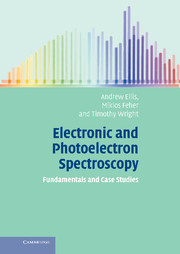Book contents
- Frontmatter
- Contents
- Preface
- List of journal abbreviations
- Part I Foundations of electronic and photoelectron spectroscopy
- Part II Experimental techniques
- Part III Case Studies
- 13 Ultraviolet photoelectron spectrum of CO
- 14 Photoelectron spectra of CO2, OCS, and CS2 in a molecular beam
- 15 Photoelectron spectrum of NO–2
- 16 Laser-induced fluorescence spectroscopy of C3: rotational structure in the 300 nm system
- 17 Photoionization spectrum of diphenylamine: an unusual illustration of the Franck–Condon principle
- 18 Vibrational structure in the electronic spectrum of 1,4-benzodioxan: assignment of low frequency modes
- 19 Vibrationally resolved ultraviolet spectroscopy of propynal
- 20 Rotationally resolved laser excitation spectrum of propynal
- 21 ZEKE spectroscopy of Al(H2O) and Al(D2O)
- 22 Rotationally resolved electronic spectroscopy of the NO free radical
- 23 Vibrationally resolved spectroscopy of Mg+–rare gas complexes
- 24 Rotationally resolved spectroscopy of Mg+–rare gas complexes
- 25 Vibronic coupling in benzene
- 26 REMPI spectroscopy of chlorobenzene
- 27 Spectroscopy of the chlorobenzene cation
- 28 Cavity ringdown spectroscopy of the a1Δ ← X3Σ–g transition in O2
- Appendix A Units in spectroscopy
- Appendix B Electronic structure calculations
- Appendix C Coupling of angular momenta: electronic states
- Appendix D The principles of point group symmetry and group theory
- Appendix E More on electronic configurations and electronic states: degenerate orbitals and the Pauli principle
- Appendix F Nuclear spin statistics
- Appendix G Coupling of angular momenta: Hund's coupling cases
- Appendix H Computational simulation and analysis of rotational structure
- Index
- References
16 - Laser-induced fluorescence spectroscopy of C3: rotational structure in the 300 nm system
Published online by Cambridge University Press: 05 June 2012
- Frontmatter
- Contents
- Preface
- List of journal abbreviations
- Part I Foundations of electronic and photoelectron spectroscopy
- Part II Experimental techniques
- Part III Case Studies
- 13 Ultraviolet photoelectron spectrum of CO
- 14 Photoelectron spectra of CO2, OCS, and CS2 in a molecular beam
- 15 Photoelectron spectrum of NO–2
- 16 Laser-induced fluorescence spectroscopy of C3: rotational structure in the 300 nm system
- 17 Photoionization spectrum of diphenylamine: an unusual illustration of the Franck–Condon principle
- 18 Vibrational structure in the electronic spectrum of 1,4-benzodioxan: assignment of low frequency modes
- 19 Vibrationally resolved ultraviolet spectroscopy of propynal
- 20 Rotationally resolved laser excitation spectrum of propynal
- 21 ZEKE spectroscopy of Al(H2O) and Al(D2O)
- 22 Rotationally resolved electronic spectroscopy of the NO free radical
- 23 Vibrationally resolved spectroscopy of Mg+–rare gas complexes
- 24 Rotationally resolved spectroscopy of Mg+–rare gas complexes
- 25 Vibronic coupling in benzene
- 26 REMPI spectroscopy of chlorobenzene
- 27 Spectroscopy of the chlorobenzene cation
- 28 Cavity ringdown spectroscopy of the a1Δ ← X3Σ–g transition in O2
- Appendix A Units in spectroscopy
- Appendix B Electronic structure calculations
- Appendix C Coupling of angular momenta: electronic states
- Appendix D The principles of point group symmetry and group theory
- Appendix E More on electronic configurations and electronic states: degenerate orbitals and the Pauli principle
- Appendix F Nuclear spin statistics
- Appendix G Coupling of angular momenta: Hund's coupling cases
- Appendix H Computational simulation and analysis of rotational structure
- Index
- References
Summary
Concepts illustrated: laser-induced fluorescence spectroscopy; symmetries of electronic states; assignment of rotational structure in spectra of linear molecules; combination differences; band heads; nuclear spin statistics.
As described in Chapter 11, laser-induced fluorescence (LIF) spectroscopy is one of the simplest and yet most powerful tools for obtaining high resolution spectra. Its high sensitivity is particularly convenient for the investigation of extremely reactive molecules, such as free radicals and ions. In this Case Study we illustrate how LIF spectroscopy can be used to obtain important information on a small carbon cluster, the C3 molecule. The spectra presented were originally obtained by Rohlfing [1], who produced C3 by pulsed laser ablation of graphite. This is a violent method for vaporizing a solid and the plasma formed above the graphite surface will undoubtedly contain carbon atoms, clusters such as C2, C3, and various cations and anions. To reduce spectral congestion, the laser ablation source was combined with a supersonic nozzle to produce a cooled sample for spectroscopic probing.
The LIF spectrum was obtained by crossing the supersonic jet with a tunable pulsed laser beam and measuring the intensity of fluorescence as a function of laser wavelength. As discussed in Section 11.2, an LIF excitation spectrum is similar to an absorption spectrum but the signal intensity depends not only on the absorption probability, but also the fluorescence quantum yield of the upper state.
- Type
- Chapter
- Information
- Electronic and Photoelectron SpectroscopyFundamentals and Case Studies, pp. 138 - 143Publisher: Cambridge University PressPrint publication year: 2005



